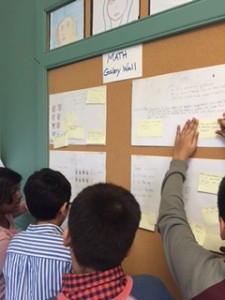
I have always considered myself more of an “English Language” teacher. So, when I moved into the junior and intermediate classroom, I felt less confident in my abilities to teach math. When planning for the year, I surveyed some other junior/intermediate teachers for recommended resources. And when planning for the classroom environment, I made sure to have a corner dedicated to math, which includes a gallery wall, manipulatives, math dictionary and texts as well as tools like calculators.
Although I was given a set of textbooks, I don’t plan or teach from the textbooks. I print the curriculum expectations specific to the grade for each strand, and use them as my guide in planning the units. Then I refer to some other resources for ideas in activities that involve group work or problem solving. Some of favourites to support my math program are:
- Introduction to Reasoning and Proof, Grades 6-8: The Math Process Standards Series, by Denisse R. Thompson and Karren Shultz-Ferrell
- Nelson’s Ontario Numeracy Assessment Package
- Good Questions: Great Ways to Differentiate Mathematics, by Marian Small
By referring to these resources, I am able to understand the concepts that need to be taught and how to differentiate using broader questions for the range of math learners in my classroom. I enjoy providing mini-lessons on strategies to support the students as well as encouraging them to share their strategies with me and the rest of the class. Our math class has become engaging and interactive, not repetitive and boring as I had feared.
We use a gallery wall to display group answers to problems. This has become an invaluable way to quickly assess understanding. Students are given the opportunity to view the gallery, see how others have solved the problem, respond with their own ideas or suggestions and acquire new learning. A week of math classes includes a range of instructional strategies, independent work, paired and group work. One of our common “go to” questions is “Does this make sense?” We are aiming for understanding rather than rote learning of facts and steps (as I learned in elementary school). So, I am enjoying learning with my students as I discover new ways to approach and solve math problems.







